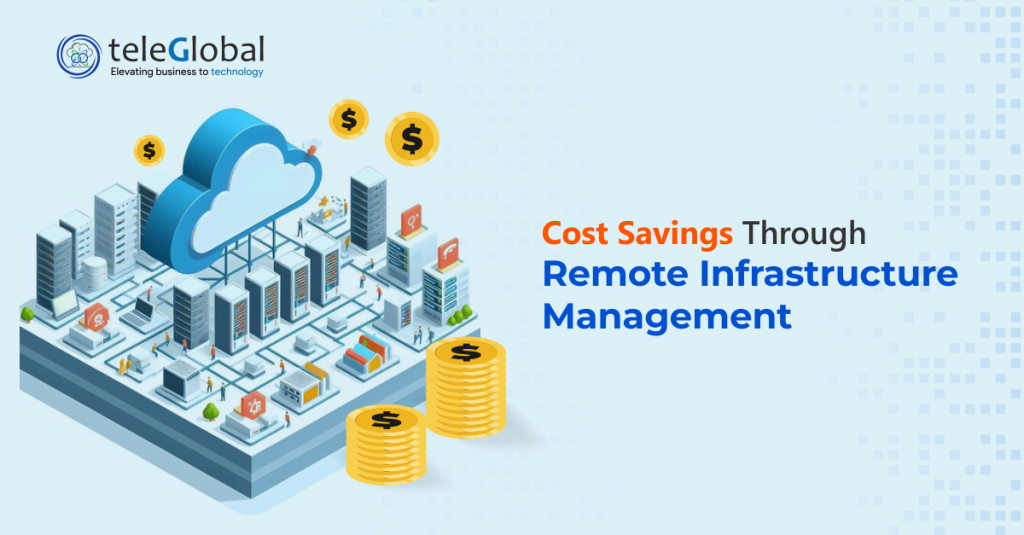
| Author: Abhinita Singh | Published: 29-Apr-2024 |
Many businesses in India, the United States, Europe, and the UAE are under pressure to cut IT costs while keeping systems strong and reliable. Leaders in these regions are expected to do more with less. In this situation, Remote Infrastructure Management is a smart way to save money and still keep systems secure and available.
But it’s not just about saving on hardware. The real value comes from making work easier, improving visibility, and helping teams make better choices about where to invest. Here are seven simple ways Remote Infrastructure Management helps companies lower IT costs and work more efficiently.
Running your own servers in an office or data center costs a lot. You have to pay for space, electricity, cooling, and regular upkeep. In some places, electricity alone can be 30% of the total cost.
Remote Infrastructure Management moves your systems to the cloud or expert-run centers. It helps you in shutting down or at least reducing your servers thereby saving money on equipment, space, and power. You are charged only on the basis of what you use, so in the long run, that saves money.
IT teams often stay busy fixing issues, answering support requests, and dealing with service problems. As systems grow, companies feel the need to hire more staff. This adds long-term costs like salaries, training, and employee benefits.
Through the deployment of these managed IT infrastructure services, businesses can minimize the environment necessary for large in-house teams. Systems are taken care of by remote proctors, 24×7 service, often at a faster pace and more efficiently. This, hence, allows your own staff to focus on key projects rather than daily fixes.
Cloud platforms have changed how companies use IT systems. But without proper checks, they can lead to waste. Many businesses keep unused systems running or set up more than they need.
Remote Infrastructure Management helps with cloud cost optimization and cloud cost management. It uses tools to check how systems are being used, find what’s not needed, and suggest ways to save money. For example, turning off unused systems at night or using cheaper storage can help lower your cloud bill each month.
Many teams spend time on updates, patches, backups, and checking logs. These jobs don’t help with big goals but still take time and money.
Remote Infrastructure Management does these jobs automatically. Systems update by themselves, backups run on time, and alerts show problems quickly. With less manual work, there are fewer mistakes and faster fixes. This makes systems more stable and easier to handle.
Unplanned downtime costs a lot. It stops work, hurts customer trust, and can cost thousands every hour depending on the business. Most outages can be avoided—they often happen because of setup mistakes, missed warnings, or late updates.
With strong IT infrastructure risk management, remote teams watch systems all the time. They find problems early and fix them before users notice. This makes systems stronger and helps teams avoid surprises. It also saves money and keeps work running smoothly.
Many systems are built bigger than needed. Companies often buy extra compute, memory, or storage just to be safe. But this unused space sits idle while other parts of the budget get tight.
Remote Infrastructure Management gives clear reports to show where systems are not being used fully. IT teams can adjust workloads, combine services, and remove waste. With smart cost-saving steps, every dollar is spent more wisely.
More companies now have remote and hybrid teams. This means workers need steady access to tools, data, and communication from anywhere. Without strong systems, speed and security can get worse.
Remote Infrastructure Management supports this setup. It keeps systems up to date, safe, and working well—without needing someone to be there in person. This saves on travel, reduces the need for office equipment, and gives every user a smooth experience, no matter where they are.

As technology gets more advanced, companies need easier ways to manage systems without spending more. Remote Infrastructure Management helps by cutting costs on hardware, cloud, staff, and daily operations—while making systems more reliable and easier to control.
At Teleglobal, we help businesses use remote management in a way that fits their long-term plans. Our team supports all parts of IT infrastructure, from saving on cloud costs to reducing risks. If your team wants to spend less without losing performance, we’re here to help you make the change.
Remote Infrastructure Management is when IT systems are handled from one place, without needing people on-site. It helps cut costs, reduces the need for office staff, and keeps things running smoothly.
By shifting infrastructure to the cloud, automating routine tasks, and identifying underused resources, RIM supports smarter spending and enables cloud cost optimization and long-term budget control.
Yes. With managed services for IT infrastructure, companies rely less on internal staff for 24 by 7 operations, saving on salaries, training, and overhead.
Remote Infrastructure Management helps all kinds of businesses. It’s great for companies with teams in many places, using cloud tools, or trying to save money as they grow.
Strong IT infrastructure risk management in a remote model means early detection of issues, automated alerting, and faster resolution—reducing the financial impact of outages.
 close
close

Hi there! At TeleGlobal, we turn your cloud vision into AI-accelerated reality. What challenge can we help you solve?
Powered by ![]() teleBot
teleBot